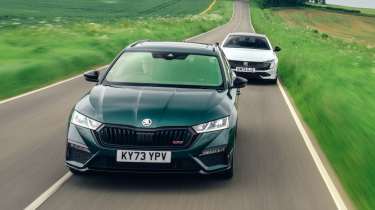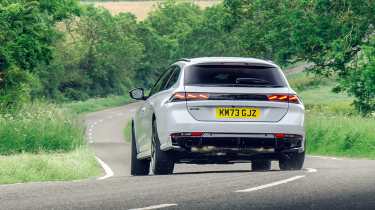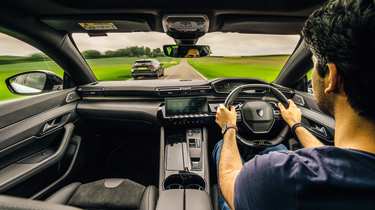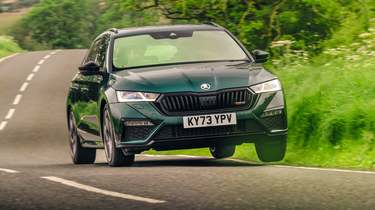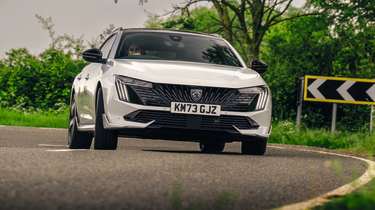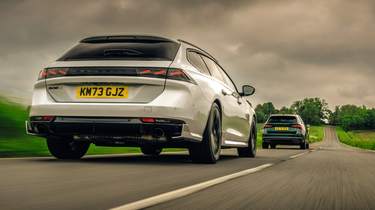Peugeot 508 PSE v Skoda Octavia vRS – fast family estates do battle
We pitted Peugeot’s eccentric 508 SW PSE up against the Skoda Octavia vRS to find out which hot estate is best
There’s just something about a spacious, plain-clothes wagon with serious performance that’s endlessly appealing. For me, it’s their ability to surprise. Some of the best moments on evo shoots are watching photographer Aston Parrott whipping our long-term Cupra Leon estate along at about Mach 9 between locations, followed by a crackle on the radio to ask why none of us can keep up in our sports cars.
Neither the Peugeot 508 SW PSE nor the Skoda Octavia vRS estate is as fast or conspicuous as Aston’s Cupra, but they still pack hot hatch speed beneath their hire-car-spec appearances. We know the Octavia well – it’s on our Fast Fleet and has already impressed with its ability to soothe on every journey and entertain when the moment allows. Its platform and 242bhp 2-litre turbocharged TSI engine are derived from the Golf GTI, but being a 1.5-ton estate car it’s a little slower to 62mph with a time of 6.7sec. These Octavias have a reputation for punching well above their weight, but comparing these specs to the hybrid, four-wheel-drive Peugeot – which costs a massive £17,390 more than the £37,785 Skoda – I worry that this might be a bit of a mismatch.
The 508 PSE is also familiar, from when we pitted it against a Volkswagen Arteon R and BMW M340i in issue 309. It’s not a car that screams ‘the thrill of driving’, but I remember John Barker effusing about its excellent suspension control and cross-country pace. I also remember the powertrain, which was a real disappointment for me – it delivered the numbers, but there was no joy to be had from extending its 1.6-litre engine. At all.
The 508 has since been facelifted with a new front facia and minor design tweaks, but the fundamentals are the same. That means you get a pair of electric motors (one coupled to the eight-speed automatic gearbox, the other driving the rear axle) working with the petrol engine for a combined 355bhp, drawing energy from a 12.4kWh battery. The 508’s a bit of a lump at 1892kg, but four-wheel drive helps it spring off the line to post a 0-62mph time of 5.2sec.
Peugeot up first, and a few miles to get used to the tiny, low-set steering wheel in your hands. It gives the 508 a sense of alertness but, as we’ll find out later, the Skoda’s more conventional ergonomics are easier to get along with. At low speed in Hybrid mode you can tickle the throttle to drive predominantly on electric power (or exclusively for 34 miles in EV mode), and the PSE is as quiet and easy to operate as a standard 508.
To get the most out of the car, though, you need to ratchet up to Sport – and, ideally, have enough juice in the battery for maximum electric power. In Sport the powertrain response sharpens up noticeably and there’s a stronger sense of the e-motors supporting the engine at low revs, with tighter reactions from the adaptive dampers too.
There’s more eagerness, more tension to the driving experience without sacrificing the 508’s sense of flow, although the steering takes on a heavily damped, weightier feel that we’d prefer to do without. The rack is otherwise accurate and well judged for speed, giving you confidence to up the pace and pick clean, precise lines.
It’s at this point that the PSE feels at its best. Leave the gearshift paddles alone, use the torque from the powertrain and it’s fast and effortless point-to-point, while the damping really finds its range as the speed climbs. You always feel connected to the surface, but bumps roll under the wheels without disturbing the car’s composure and even the most evil, sudden compressions are dealt with in one clean hit. Impressive given how much the PSE weighs.
Deputy editor James Taylor has been following in the Skoda, and we swap keys. ‘It’s been a long time since I’ve driven an Octavia vRS, but this feels much more agile to me than the last one I drove,’ he notes. ‘I only noticed the extra length over a Golf when doing three-point turns’.
The Octavia is smaller than the Peugeot, and even in this rich Royal Green metallic paint it’s more discreet too. Look closely at the 508 and you’ll notice aero flicks on the lower apron and how its widened tracks (by 24mm front, 12mm rear) push the wheels flush to the bodywork, making the vRS look restrained by comparison.
It’s the same story inside – the 508 is almost concept car-like with its angled surfaces and mix of materials, but you feel more instantly at home in the Skoda’s cabin. The less said about the Golf-derived HMI system the better, but the quality is excellent, the suede and matt carbon trim is tastefully done and it’s nice to be holding a proper-sized steering wheel.
You have plenty of modes to play with in the vRS, but setting it up is quite simple. The steering is best left in Comfort mode for the most transparent feel, the drivetrain is perkiest in Sport, and then it’s a case of switching between the (£1020) DCC damper settings depending on the road and your mood. Oh, and don’t forget to switch the lane assist off with the shortcut button on the steering wheel, because it’ll drive you up the wall on a tight B-road.
There’s a pleasing familiarity about the Skoda that makes it easy to wring performance from it straight away. Where the Peugeot has two stages to its acceleration – the first hit coming from the electric motors, the second when the gearbox kicks down moments later – the Octavia just does what it’s told, and does it really rather well.
You need some revs on the board to keep the turbo spooled, but once up to speed the performance gap to the Peugeot is smaller than it appears on paper (the key difference is that initial surge out of corners, where the 508 pulls a couple of car lengths ahead thanks to the electrical assistance). Neither car makes a great sound, but I much prefer the Octavia’s industrial rumble over the Peugeot’s weedy, strained note at high revs, and naturally start using the paddles more than I did in the 508 to keep the engine fizzing along.
To begin with, and especially with the dampers backed off, the Skoda feels more ordinary, a little lazier and the least reactive of the pair. Perhaps it’s the Peugeot’s smaller wheel magnifying my inputs, but the Octavia feels fractionally less locked-on at speed and settles into a softer stride.
Put some energy into your driving and the body moves around more too, but the Bridgestone S005s dig in and find strong bite at the front, that initial roll bleeding into a suggestion of yaw to help you around corners. If you’re in the right gear and the engine is lit (not always the case, as the DSG sometimes ignores your requests for a downshift), you can feel the front diff pulling you tighter when you get on the throttle, the tyres nibbling at the surface as you power away. You can drive the Skoda like a big hot hatch, and it’ll thank you for it.
Finding the same sort of malleability and involvement in the 508 isn’t easy. Its extra weight means that the harder you push, the more it feels like you’re bullying the car around rather than working with it, and the ESC is quick to shut down any attempt to influence the balance with a sharp lift or a trailing brake. You can lean into the control of the dampers and cover ground quickly, but the handling is more prescriptive and simply not as much fun. ‘It feels like the car is being asked to do things it doesn’t want to do,’ says Taylor. ‘I didn’t find the powertrain particularly inspiring, and I didn’t enjoy driving it as much as the Skoda.’
There’s no doubt the 508 would be cracking to live with, particularly taking its electric-only range and running costs into account. It’s the faster of the two, the more visually interesting and it has a lovely sense of calmness and control at speed. It also offers more space than its Czech rival, if fewer clever storage solutions. But the Skoda is more enjoyable more of the time and for a whole lot less money, while nailing every base an estate car should. For my 180-mile commute, the Octavia’s are the keys I’d want in my hand.

